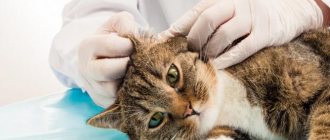What will you learn from the article?
- Where does a cat get worms?
- Symptoms
- Types of worms Tapeworms (cestodes)
- Roundworms (nematodes)
- Flukes (trematodes)
- Medicines for helminths
Helminths (worms in cats) are a very common parasitic disease that can pose a serious threat to the health and life of a pet. From this article you will learn what to do in case of helminthiasis, how to deworm (what anthelmintic drugs to give) and, most importantly, how to prevent your cat from becoming infected with parasites.
Where does a cat get worms?
Worm larvae and adult parasites are found in the environment: in the soil, on the grass, in water bodies. Therefore, it does not mean at all that if your cat is an indoor cat and does not go outside, then he cannot become infected with worms. You yourself can bring the larvae on the soles of your shoes or on your clothes.
Other sources of infection:
- when your cat eats raw fish, meat, or tap water;
- when fleas appear, there is a possibility of your pet becoming infected with worms;
- upon contact with sick animals, contaminated objects (sand, soil) and feces;
- Intrauterine infection of kittens from a pregnant cat is possible.
What is the harm from worms?
A pet infected with worms is a danger to all family members. Worm eggs are transmitted to people through unwashed hands before eating or frequent kissing of your pet.
Parasites have a detrimental effect on a cat's body. The longer they are present in it, the more weakened the pet is:
- Immunity decreases;
- Feeling worse;
The animal experiences pain and spasms;
- Lethargy and loss of interest in others.
Worms pose a serious danger to kittens. A fragile body cannot cope with their destructive effect. A large number of helminths in a kitten’s body can lead to its death.
Symptoms
- The presence of fleas is a direct sign of the appearance of worms in a cat.
- Invasive parasites can live not only in the intestines, but also in the bronchi, muscles, and liver, so a number of symptoms may be observed indicating the presence of helminths:
- general exhaustion of the body;
- dull coat;
- lethargic state of the pet;
- refusal of food or, conversely, increased appetite;
- thirst;
- weight loss;
- vomiting and diarrhea (the presence of parasites can be seen in vomit or feces).
- Small rashes around the anus.
- Kittens have swollen bellies, very pale mucous membranes (due to anemia), an upset stomach is replaced by constipation, bloody diarrhea.
Why worm a cat?
Pets often suffer from worms. Parasites that have settled inside the body harm the health of the animal and can be deadly. The most common parasites diagnosed in cats are:
- a tapeworm that grows in a pet's intestines. The length of the parasite reaches 45-50 cm. With the help of suction cups and hooks, adult individuals are attached to the intestinal mucosa. Against this background, an inflammatory process develops;
- A flatworm that parasitizes the internal organs of a cat and causes severe damage and distress. When a cat is infected with flatworms, the animal suffers from fever, vomiting, severe weakness, hair loss and problems with the digestive system;
- a roundworm that lives in the small intestine. Against the background of helminth infection, the cat suffers from exhaustion, systematic vomiting, and disturbances in the functioning of the digestive system.
For your information! It is very important to worm your pets to keep them healthy. In addition, it is worth considering that tapeworms and roundworms can be transmitted to people. Small children often suffer from helminthic infestations.
Anthelmintics
Before vaccination, the animal must be wormed.
Types of worms
The following types of worms parasitize cats. Each type has its own symptoms and routes of infection.
Tapeworms (cestodes)
Long and flatworms can reach a length of up to 70 cm. The body of these worms consists of many segments, in each of which larvae mature.
When the larvae mature, they separate and come out together with the feces, while the segmented body of the parasite grows continuously, and new segments with larvae appear to replace the separated segments.
Routes of infection
Cats become infected with this type of worms by eating raw meat and fish. Stray animals often become infected with cestodes by eating rats or mice. Infection through larval carriers, fleas, is also possible. Helminths parasitize the walls of the cat's small intestine.
Signs of tapeworm infestation:
- changes in the pet’s body weight (the weight either increases sharply, or the cat, on the contrary, rapidly loses weight);
- change in appetite (the cat is insatiable or, on the contrary, refuses food);
- large, “inflated” belly;
- hair loss;
- Excessive licking in the anal area.
Why are they dangerous?
The cat's gastrointestinal tract becomes clogged with worms, causing intestinal obstruction. Possible death.
As you can see
It is very common to see tapeworm segments around the anus of a sick animal - these segments resemble grains of rice or sesame. Also, individual parts of cestodes are found on the animal’s bedding. In a more severe form of worm infestation, parasites can be seen in the vomit.
Roundworms (nematodes)
The most common type of internal parasites that infect cats. There are many varieties, but the most common in our pets are roundworms. In appearance, the parasites resemble spaghetti, which is where the name “round” comes from. The length of roundworms usually reaches 5 cm, but longer individuals are also found.
Routes of infection
Kittens can become infected with roundworms through their mother's milk. The danger of infection lies in wait for an adult cat when eating rodents, raw meat and in contact with an infected animal.
Signs of roundworm infection:
- weight loss;
- enlarged belly;
- vomit;
- diarrhea;
- general weakness.
Why are they dangerous?
Worms accumulate in the small intestine, injure the gastric mucosa, and can clog the bile ducts and intestines. They can parasitize almost all organs of the animal, having a strong toxic and allergic effect on the body.
As you can see
With intense helminthic infestation, nematodes can be seen in sputum after coughing or in vomit. Roundworm eggs can accumulate in the folds around the animal's anus.
Flukes (trematodes)
Parasites that can be localized anywhere: in the gastrointestinal tract, liver, bile ducts, respiratory organs. These are flatworms with suckers, with which they are firmly attached to the tissues of internal organs, most often the liver. With these suckers, hermaphrodite worms attach to the tissues of the cat's internal organs, eating and destroying them.
Routes of infection
Infection occurs by eating raw fish, seafood or through raw water.
Symptoms of fluke infection:
- cough;
- dyspnea;
- jaundice;
- vomit;
- weight loss;
- diarrhea;
- painful stomach;
- depressed state.
Why are they dangerous?
The activity of parasites disrupts the patency of the bile ducts, causing cirrhosis and liver failure. This can cause lethargy and death.
As you can see
The moving parts of the flukes can come out through the cat's anus. If you look closely, you can see tiny translucent parts of the parasite around the animal's anus, on its bedding.
Complications after deworming a cat
Deworming can only be harmful if the procedure is performed incorrectly or the medications are not suitable for the cat. As a result, complications may appear:
- sudden weight loss;
- severe diarrhea, vomiting;
- dyspnea;
- problems with stool (up to intestinal failure);
- allergic reactions, anaphylactic shock;
- bleeding in the gastrointestinal tract;
- congenital defects in the next generation of kittens;
- sudden changes in blood pressure;
- breathing problems (even stopping);
- kidney dysfunction;
- foaming at the mouth.
If worming is missed according to schedule and the degree of parasite infestation is high, this will lead to the death of the pet. A fatal outcome can also occur in a cat that is severely weakened by the disease and suffers from multiple organ failure. Sometimes it is impossible to save a cat even in a hospital setting.
Cats need to be dewormed (dewormed) regularly, even for pets. A timely and correctly performed procedure will help protect the cat from the appearance of parasites, intoxication of the body, dysfunction of internal organs, and sometimes even save its life.
Diagnostics
A final diagnosis can only be made by a veterinarian after studying the anamnesis and taking the animal’s feces and blood for analysis. A stool sample is collected for three consecutive days to rule out a “false negative diagnosis.”
If the owner notices particles of worms in the cat’s feces or on the animal’s body, then this should also be reported to the veterinarian.
Important!
Please note that parasite larvae may persist in the milk of nursing cats. Therefore, even if the mother cat has a negative test for worms, it is necessary to carry out thorough anthelmintic therapy for the babies.
Home deworming regimens
How to deworm a cat at home? When choosing a drug, it is important to consider the spectrum of action. Despite the universality of most medications, there is a category of drugs that are active against nematodes and cestodes.
Putting a cat to sleep: options at home and without a veterinarian
It is also important to take into account which animal needs to be dewormed. For aggressive cats, it is advisable to use drops on the withers; for calm pets, you can choose any medication option. When calculating the dosage, the weight of the animal and the individual characteristics of the body are taken into account. If hypersensitivity to one of the components of the product is detected during processing, you should immediately seek help from a veterinarian. It is advisable to alternate the drugs used for prophylactic purposes.
Note! To minimize the risk of infection with worms, it is necessary to systematically clean the cat's litter box and replace the litter. The tray itself is rinsed with boiling water. Raw meat and fish should be excluded from the diet.
Antihelminthics for cats
Anthelmintic drugs are prescribed for medicinal purposes by a veterinarian after all tests have been carried out, the type of parasites, the location and degree of helminthic infestation have been determined.
The doctor must select the brand and form of a targeted drug that acts on a specific type of worm. Or prescribe a medicine with complex action if the cat is infected with several types of helminths or the type of worms could not be determined.
For the purpose of prevention, anthelmintic drugs for cats are prescribed 2-4 times a year. It is mandatory to carry out antiparasitic treatment before mating, before vaccinations and simultaneously with anti-flea drugs.
Medicines for helminths
In veterinary pharmacies, anti-worming drugs for cats with targeted and complex action are widely available in various forms of release:
- Drops on the withers are the most popular products, characterized by quick action and ease of application. The drops are applied to the withers and between the animal's shoulder blades - there is no need to force the cat to drink the bitter medicine.
- Profender (Bayer) - price in Russia for 1 pipette 350-450 rubles / in Ukraine 110-230 UAH);
- Dironet Spot-on (Agrovetzaschita) – price in Russia 350 rubles / in Ukraine 160 UAH.
- Stronghold (Pfizer) – price in Russia 1150 rub. / in Ukraine 550 UAH.
- Anti-worm tablets - given to the animal along with food or “in its pure form”. Preparations with high effectiveness of a complex and targeted (for one type of worm) remedy. Individual selection is possible taking into account the type of parasites, the degree of infestation and the condition of the cat.
- Kanikvantel plus - price in Russia 195 rubles / in Ukraine 70 UAH;
- Enwire - price in Russia 165 rubles / in Ukraine 78 UAH;
- Drontal (Bayer) – price in Russia 320 rubles / in Ukraine 179 UAH;
- Milbemax – price in Russia 330 rubles / in Ukraine 145 UAH;
- Pratel - price in Russia 38 rubles / in Ukraine 6 UAH;
- Trontsil - price in Russia 215 rubles / in Ukraine 15 UAH;
- Febtal – price in Russia 150 rub. / in Ukraine 71 UAH.
- Suspensions or pastes are given to the animal orally using a dispensing syringe. It is convenient to dose and give to cats that refuse to eat tablets.
- Prazicide for adult cats - price in Russia 108 rubles / in Ukraine 45 UAH;
- Prazicide sweet suspension for kittens - price in Russia 127 rubles / in Ukraine 38 UAH.
- Sugar cubes - given to the animal as a treat, with food, or dissolved in water and fed to the animal through a syringe. Animals willingly eat the medicine.
- Polyvercan - price in Russia 605 rub. / in Ukraine 310 UAH.
How to use an anthelmintic drug correctly
- modern drugs for preventive purposes are given once in the morning, a preliminary fasting diet is not required;
- when treating worms in a cat, the drug must be given again after 10-14 days;
- before each vaccination, it is necessary to give antihelminthic drugs 10-15 days before the expected date of vaccination;
- you also need to give antihelminthic drugs 3 weeks before childbirth and 3 weeks after;
How to deworm kittens
- It is not recommended to give anthelmintic drugs to kittens younger than 8 weeks;
- kittens are dewormed for the first time at the age of 2 months, when the body is stronger and can perceive the toxic substances of anthelmintic drugs;
- the drug is chosen on the recommendation of a veterinarian, the dosage is calculated based on the age and weight of the kitten;
- repeat the procedure 10-14 days after the first dose.
Folk remedies
Traditional medicine for worms in cats does not have proven effectiveness and is presented in the article for informational purposes.
- Give a decoction of chamomile or fennel to drink instead of water.
- Cut the onions into 4 parts and pour a glass of warm boiled water. Give your cat this water to drink in the morning on an empty stomach for 7 days.
- Common tansy. Pour 1 tablespoon of flowers with a glass of boiling water and leave for 1 hour, then strain. Give the cat this infusion 2-3 times a day, then feed it no earlier than 30-60 minutes later.
- Alcohol tincture of wormwood is used 10 drops 2 times a day. Feed the cat no earlier than every 30-60 minutes.
- Carrot juice enemas (20 ml) once a day for a week.
Timing of deworming
Deworming is carried out 1–3 weeks before vaccination, depending on the type of anthelmintic. If the kitten’s parents did not undergo routine deworming before mating, or if live helminths are noticed in the feces, the drug must be given again after 10 days. You should not vaccinate your cat immediately after deworming. It is necessary to wait time for the pet’s body to fully restore its immune reserves.
It is also recommended, after eliminating the parasites, to feed the pet with prebiotics and probiotics that restore the intestinal microflora. If there are a large number of parasites, you may even need a laxative, such as Vaseline oil. If your cat is dewormed correctly and in a timely manner, she will easily tolerate vaccination.
Prevention
The disease is easier to prevent than to treat, and therefore, to minimize the risk of your cat getting worms, do the following:
- Preventive use of antiparasitic drugs for fleas, ticks, and worms once every 3 months. First we use anti-flea products, after 3 days - against worms.
- Do not feed the animal raw meat, drink only boiled/settled water.
- Avoid contact with street animals.
- Regularly carry out antiparasitic treatment of the cat's place and scratching posts. Keep your cat's grooming supplies clean.
- Clean your house/apartment regularly and take off your shoes in the hallway.
Important!
Remember that most of the helminths that infect cats are also dangerous for humans, so if your pet is found to have parasites, worry about your health too.
How to choose a dosage and give medicine to an animal
It is especially important to follow the dosage. If you give an insufficient dose, only the weakest helminths will die, while the rest will survive and eventually become resistant to the drug. If you exceed the dosage, side effects may develop.
When choosing an anthelmintic, it is necessary to take into account the cat's weight and age. To correctly calculate the dose, it is recommended to weigh your pet before deworming.
How to get a cat to swallow a pill? You can disguise it with a piece of some treat. If this method does not work (the cat eats the treat and leaves the tablet), use another method. The pet's mouth is opened and the tablet is placed on the root of the tongue. Then they clench their jaws and stroke the neck from top to bottom, which causes swallowing movements. If you are afraid of an animal bite, you can use a tablet dispenser (introducer).
It is quite difficult for kittens to correctly calculate the dose: due to its small weight, the tablet has to be divided into several parts. In such cases, it is recommended to use a suspension.
If your cat refuses to take anthelmintic, you can use a convenient new product - a dewormer in the form of drops on the withers. These drugs should not be given by mouth, at the risk of being bitten. It is enough to apply to the skin in the withers area, in a place inaccessible to licking.
Owner stories
Sofia: “We adopted a cat from a shelter. It turned out that the cat had worms. Moreover, there were a lot of them, all the feces were strewn with larvae and parts of parasites, such small white things. We suffered with her until the veterinarian advised us this treatment regimen: Kanikquantel suspension three times with an interval of 2 weeks. We're doing well now."
Tamara: “My son brought a kitten from the street. I immediately realized that the cat had worms - the baby’s tummy looked like an inflated balloon. Poor thing, he suffered while he was a wanderer. The veterinarian said to give Prasitab tablets. One tablet is designed for an animal weighing 4 kg. I gave a little less than half, crushed it into powder and diluted it with water. This mixture was poured into the baby using a syringe without a needle.”
Main types of helminths in cats
Several types of anthelmintic drugs are commercially available:
- against a specific type of worm;
- complex type with a wide spectrum of action.
How to train a cat to use the toilet: instructions at home
You can purchase drugs in the form of:
- solutions for injections;
- drops;
- suspensions;
- tablets.
How to deworm a cat? It is necessary to choose the right medication, taking into account:
- individual characteristics of the body;
- pet's character;
- age category of the pet;
- the presence of children in the house who are in contact with the cat.
Note! Only healthy animals can be dewormed. Before giving your cat a pill, it is important to read the instructions and pay special attention to the sections on contraindications and side effects of the medication.
Folk remedies for use at home
How to deworm a cat at home other than tablets and suspensions? Some owners of furry purrs prefer folk remedies. The most effective of them are presented below.
- Sugar solution. If the cat does not want to drink this water, you can use a syringe (without a needle!) to pour the product into the pet’s mouth.
- A decoction of fennel or chamomile is given to the cat daily at the beginning of the day. It is advisable to carry out such deworming every month. It is better to check with a veterinarian whether it is possible to deworm a nursing cat in this way.
- Onion infusion. To prepare, you will need to finely chop the onion and pour boiling water over it. The water is infused for 24 hours and given to the pet in the morning instead of ordinary drinking water. The recommended duration of therapy reaches 5 days.
- Tincture of tansy (common). A small amount of herb is poured into a glass of boiling water. The healing water is infused throughout the day. The cat is fed the tincture for a week. It is recommended to pour at least 25 ml of products per day. It is better to ask your doctor how to deworm a kitten in this way.
Preventive measures
It is always easier to prevent a problem than to treat it, which means that it is recommended to prevent helminths for the animal. To do this, you will need to give medications against worms, fleas and other parasites once a quarter. Initially, fleas should be removed, and after 3 days it will be possible to give deworming medications.
For prevention, it is recommended to exclude raw fish and meat from the diet, and give only boiled or settled water. It is better to keep indoor cats away from street cats to avoid infection. You need to keep the cat's area clean and treat it with anti-parasite products. The house itself should also be kept clean.
Many worms that infect cats are no less dangerous for people, therefore, if helminths appear in your pet, you must additionally check yourself for the presence of worms.











